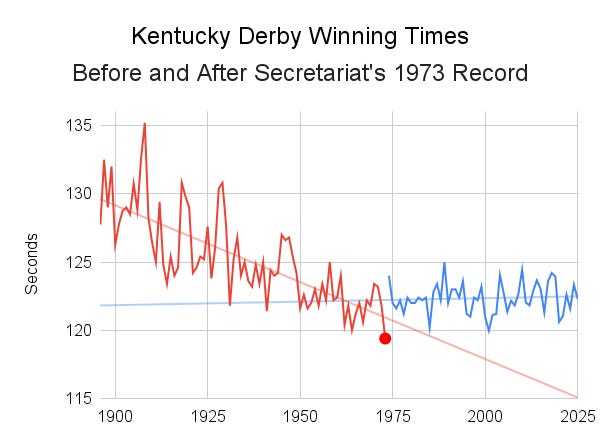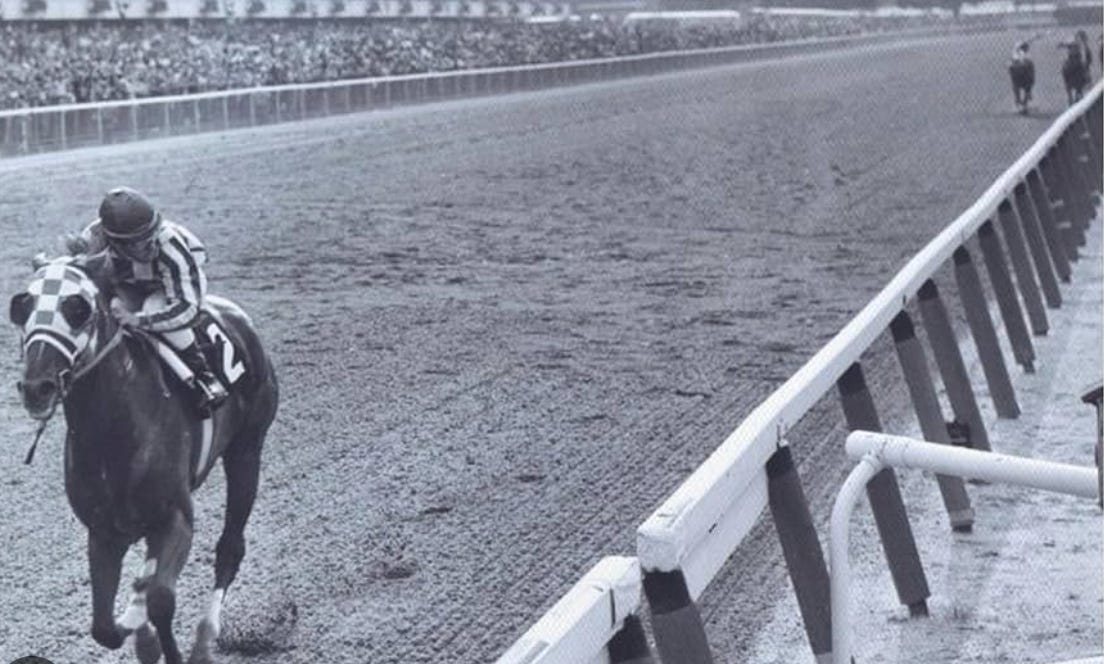1973: When Eugenics Stopped Working
All 19 entrants in the Kentucky Derby were descendants of Secretariat, but why can't thoroughbred eugenics produce a faster horse than the legend?
In today’s Kentucky Derby, Sovereignty upset Journalism (which sounds like some kind of omen that would appeal to Curtis Yarvin).
From the Louisville Courier-Journal:
Every horse running in Kentucky Derby 2025 is a descendant of this racing legend
Stephanie Kuzydym
… In fact, a search of pedigrees shows every horse [there were 19 entrants] running in the 151st Kentucky Derby is a descendant of Secretariat.
While it sounds impressive, more often than not, if you go back six generations in most horses, you'll find they're a descendant of some great, like Secretariat or Northern Dancer.
Secretariat sired 663 named foals, so it’s not surprising that four to eight generations later, an awful lot of thoroughbreds count him as an ancestor. Similarly, it’s widely believed that all Europeans today are descendants of Charlemagne from about 40 generations ago (if you go back 40 generations in your family tree, you have over a trillion slots for ancestors).
Note that very few thoroughbreds are conceived unless somebody thinks it would be worth investing money in them because they have a chance to be a winner in racing (or in the few other competitions that can use thoroughbreds, like dressage). They’re too huge, high-strung, and generally terrifying to be bred for casual horseyback riding.
As they say: How do you make a small fortune by owning race horses?
You start with a large fortune.
So, virtually all thoroughbreds have carefully curated aristocratic family trees.
This can be a problem for screenwriters of horse racing movies. From my review of the 2003 movie Seabiscuit by Bill Clinton’s speechwriter Gary Ross:
Ross rewrites history to inject a bogus political analogy between Seabiscuit and the New Deal. …
According to Ross, the plucky little horse's 1938 defeat of the elitist War Admiral gave the Little People a Reason to Hope -- just like the Roosevelt Administration did. …
Thoroughbreds are inbred aristocrats. Seabiscuit was actually the grandson of Man O' War, the most blue-blooded horse of the age, and the half-nephew of his archrival War Admiral.
Secretariat, who still holds the records in all three Triple Crown races from his legendary 1973 campaign (his Belmont performance remains the world record at 1.5 miles on any track ever), went on to be a successful sire (especially through his daughters). But he doesn’t rank with the greatest sires of all time like Northern Dancer and Bold Ruler (father of Secretariat and grandfather of Seattle Slew).
My offhand guess is …
Paywall here.
that Secretariat’s enormous heart (said by the racehorse veterinarian who performed the autopsy on Secretariat when he died in 1989 at age 19 to be 30% larger than any other thoroughbred’s he’d ever examined) required a lot of unusually scaled anatomical infrastructure to support it. So he didn’t have one magic gene that could be passed on; he had a very rare combination of genes that worked together perfectly in his case, but were hard to reassemble in descendants.
Thoroughbred breeding is of course a form of eugenics, which is the worst thing ever. From JSTOR Daily:
The breeding of race horses validated those aspiring to belong to an American elite while feeding into racist beliefs about genetic inheritance.
By: Livia Gershon May 4, 2022
The Kentucky Derby has been an American tradition for almost 150 years. As historian Brian Tyrrell writes, in the early decades of the twentieth century, horse racing was one of the nation’s most popular spectator sports. The breeding of fast horses also sparked a widespread interest in genetics that lined up closely with eugenics and the “scientific” racism it was associated with.
… By the 1920s, breeders were using the increasingly widespread language of Mendelian genetics to talk about their efforts.
“In a nation obsessed with blood but lacking in titled aristocrats, elites consolidate their authority by being well-wed,” Tyrrell writes. “They played out this fantasy with the horses on their breeding farms, who, unlike intransigent sons or daughters, lacked the ability to object to a negotiated pairing.”
By the 1920s, breeders were using the increasingly widespread language of Mendelian genetics to talk about their efforts. The racing magazine The Blood-Horse even informed its readers about new scientific developments by publishing abstracts of corn-breeding experiments.
Experimenting with corn-breeding is of course another pseudoscience that completely failed, as you can see by how skinny everybody is these days.
And the interest ran both ways, with geneticists looking to records of horse pedigrees to learn more about inheritance.
Tyrrell highlights the extensive crossover between elite horse breeders and wealthy “scientific” thinkers interested in the improvement of humanity through eugenics. The Eugenics Record Office, which advocated for eugenics programs based in scientific racism, was founded in 1909, thanks to the support of Mary Williamson Averell Harriman, widow of Edward Henry Harriman, a financier, railroad executive, and—most importantly—thoroughbred breeder. The office’s director, Harry H. Laughlin, devoted a great deal of energy to studying racing forms, pedigrees, and breeding charts.
In general, Anglos were obsessed with horse breeding for hundreds of years. They didn’t have as many other sports as we do, plus fast horses were valuable in war. As I pointed out in 2021, Shakespeare tend to use the word “race” in reference both to what racehorses do and to breeds of racehorses.
Judging by Kentucky Derby-winning times from 1896, when the current length was established, racehorse eugenics was a big success up through Secretariat. But, since then …
The trend line fell by about 5% from 1896 through 1973, but has gone up marginally since then.
A few things to note: electronic timing to the hundredth of a second was introduced in 2001. Before then, time was measured to a fifth of a second. That may have slightly increased times.
Race tracks are kept a little softer these days to protect horses.
Strategies are now more tactical (a narrow win pays as much as a 31-length win, unlike in human running where a world record brings bigger appearance fees), rather than focused on just blowing away the competition.
Horse racing is a smaller business relative to other sports than in 1973, but now there is lots of Arab money in it, which wasn’t true before the oil price hike that autumn.
But mostly it looks like a few hundred years of breeding maxed out the genetic potential of the closed studbook with Secretariat.





Here's an interesting question: in what field has eugenics produced the most gains and what the fewest?
Corn-breeding seems like a candidate for the most gains over the last 6,000 years. Perhaps chicken or turkey breeding.
Horse breeding over the last half century might be a candidate for least. Same for dog-breeding.
It seems like early in the process of inventing scientific breeding, it attracts the best minds of the age, but after awhile, in the fields that are less profit-driven, sillier people and faddish tastes take over.
For example, German Shepherds were arguably the capstone success of 19th Century dog breeding. But lately, German Shepherd breeders obsess over dumb stuff like sloping hindquarters.
Nobody cares about turkeys except as vehicles for making money, so turkeys keep getting more immense due to the ruthless rationality of turkey breeders.
But lots of people love German Shepherds, so they've managed to screw them up.
Another approach would be to only graph Kentucky Derby times on tracks listed as "fast." The 2025 track was listed as "sloppy" and was almost 3 seconds slower than Secretariat on a fast track in 1973.